Marketing Report: Analyzing NZ Education Services in the Japan Market
VerifiedAdded on 2023/01/05
|39
|11194
|87
Report
AI Summary
This report presents a comprehensive marketing analysis focused on promoting New Zealand's education services within the Japanese market. It begins with an executive summary, outlining the key objectives and findings, followed by an introduction that establishes the context of the report. The situational analysis delves into market feasibility, including market size, trends, and the target customer demographic. An economic benefit analysis assesses the potential financial advantages, supported by a PESTLE analysis to evaluate external factors. Competitive analysis is conducted using a SWOT framework to identify strengths, weaknesses, opportunities, and threats. The report then explores the application of marketing principles within the education sector, including the 7 Ps marketing mix, New Zealand's unique selling proposition, pricing strategies, and distribution channels. An integrated marketing and communications plan is proposed to enhance marketing efficiency and communication. The report concludes with an evaluation and control section, along with overall conclusions and recommendations for effective market entry and growth.

Running head: MARKETING
Marketing
Name of student
Name of University
Author note
Marketing
Name of student
Name of University
Author note
Paraphrase This Document
Need a fresh take? Get an instant paraphrase of this document with our AI Paraphraser
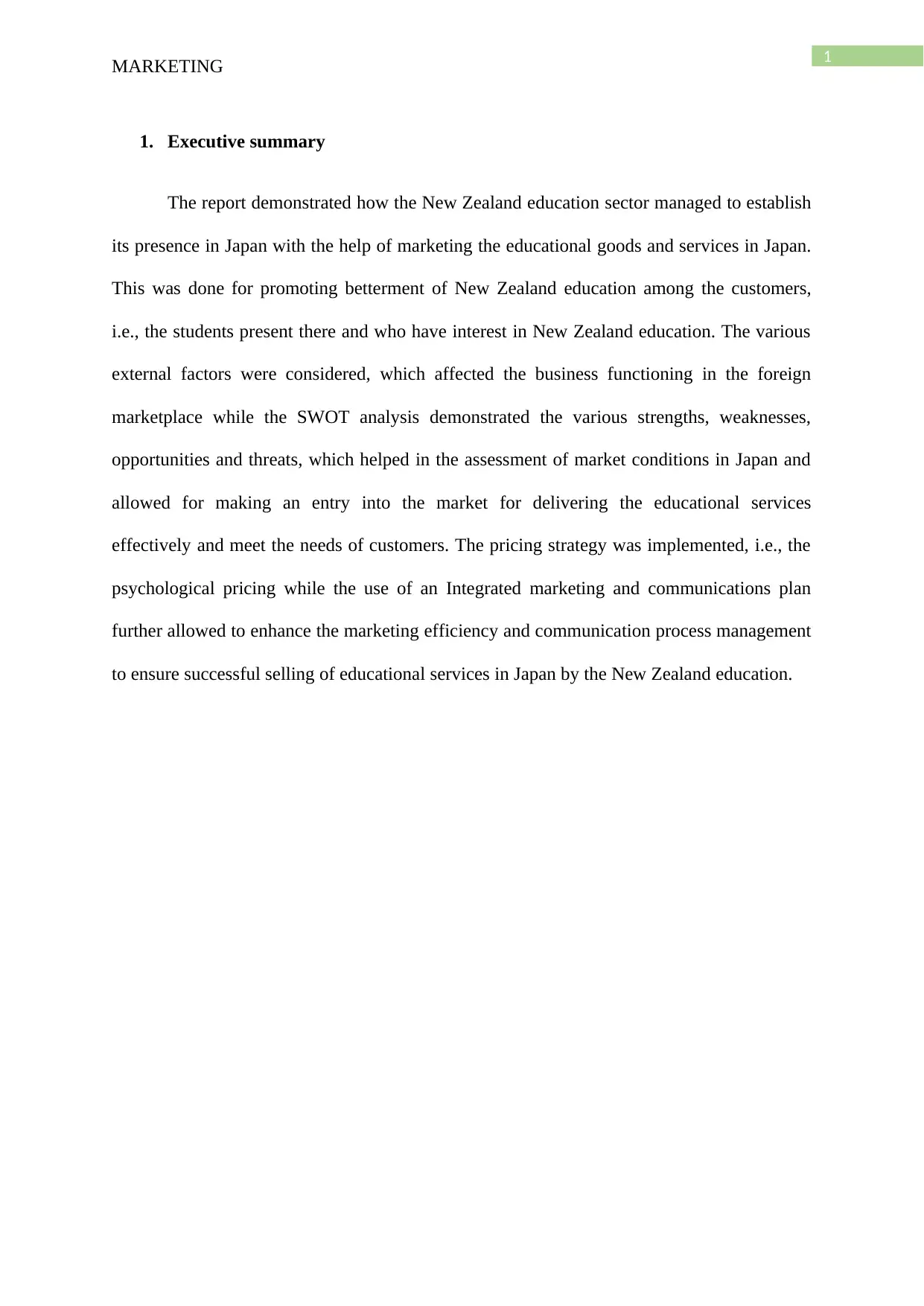
1
MARKETING
1. Executive summary
The report demonstrated how the New Zealand education sector managed to establish
its presence in Japan with the help of marketing the educational goods and services in Japan.
This was done for promoting betterment of New Zealand education among the customers,
i.e., the students present there and who have interest in New Zealand education. The various
external factors were considered, which affected the business functioning in the foreign
marketplace while the SWOT analysis demonstrated the various strengths, weaknesses,
opportunities and threats, which helped in the assessment of market conditions in Japan and
allowed for making an entry into the market for delivering the educational services
effectively and meet the needs of customers. The pricing strategy was implemented, i.e., the
psychological pricing while the use of an Integrated marketing and communications plan
further allowed to enhance the marketing efficiency and communication process management
to ensure successful selling of educational services in Japan by the New Zealand education.
MARKETING
1. Executive summary
The report demonstrated how the New Zealand education sector managed to establish
its presence in Japan with the help of marketing the educational goods and services in Japan.
This was done for promoting betterment of New Zealand education among the customers,
i.e., the students present there and who have interest in New Zealand education. The various
external factors were considered, which affected the business functioning in the foreign
marketplace while the SWOT analysis demonstrated the various strengths, weaknesses,
opportunities and threats, which helped in the assessment of market conditions in Japan and
allowed for making an entry into the market for delivering the educational services
effectively and meet the needs of customers. The pricing strategy was implemented, i.e., the
psychological pricing while the use of an Integrated marketing and communications plan
further allowed to enhance the marketing efficiency and communication process management
to ensure successful selling of educational services in Japan by the New Zealand education.
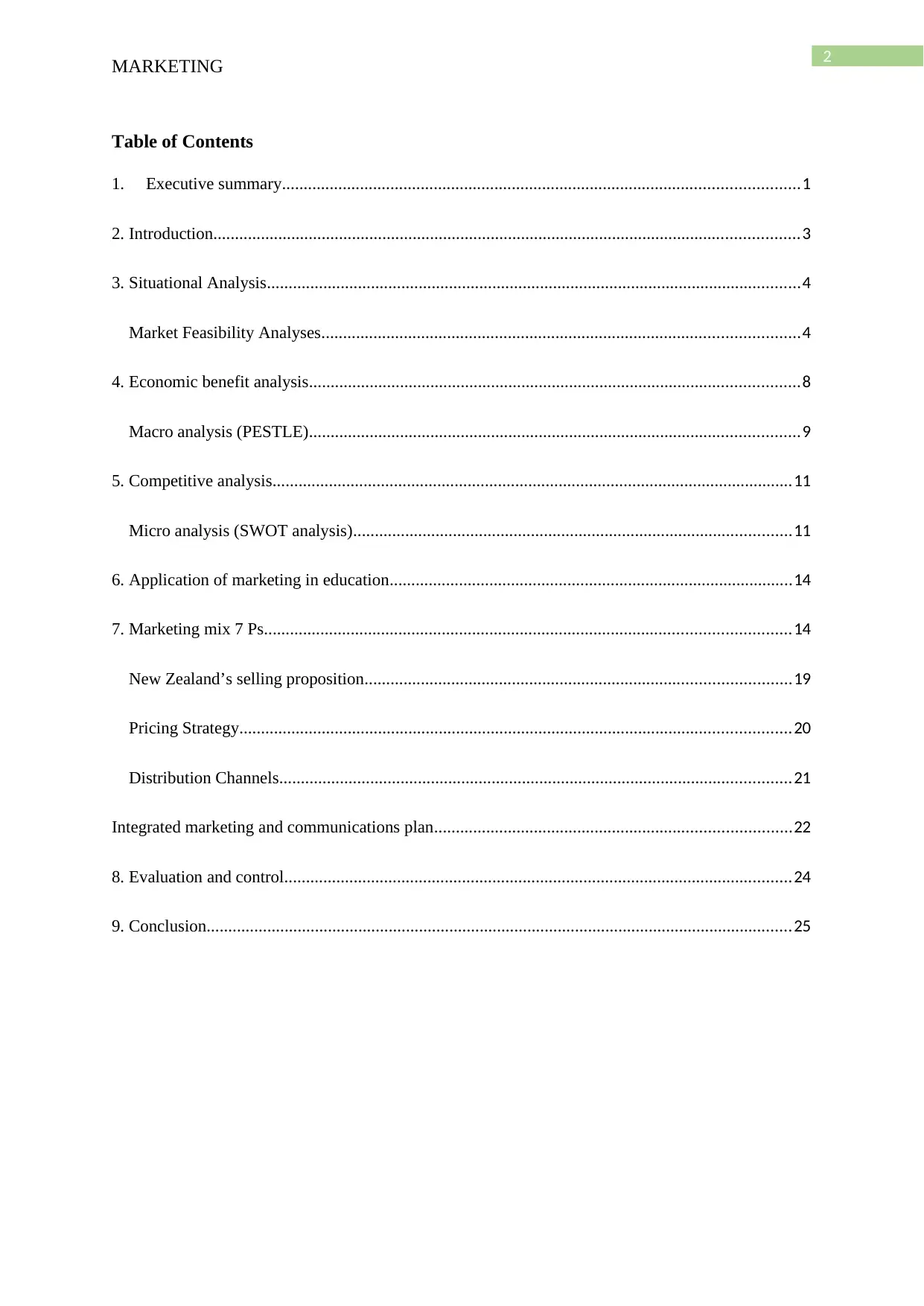
2
MARKETING
Table of Contents
1. Executive summary.......................................................................................................................1
2. Introduction.......................................................................................................................................3
3. Situational Analysis...........................................................................................................................4
Market Feasibility Analyses..............................................................................................................4
4. Economic benefit analysis.................................................................................................................8
Macro analysis (PESTLE).................................................................................................................9
5. Competitive analysis........................................................................................................................11
Micro analysis (SWOT analysis).....................................................................................................11
6. Application of marketing in education.............................................................................................14
7. Marketing mix 7 Ps.........................................................................................................................14
New Zealand’s selling proposition..................................................................................................19
Pricing Strategy...............................................................................................................................20
Distribution Channels......................................................................................................................21
Integrated marketing and communications plan..................................................................................22
8. Evaluation and control.....................................................................................................................24
9. Conclusion.......................................................................................................................................25
MARKETING
Table of Contents
1. Executive summary.......................................................................................................................1
2. Introduction.......................................................................................................................................3
3. Situational Analysis...........................................................................................................................4
Market Feasibility Analyses..............................................................................................................4
4. Economic benefit analysis.................................................................................................................8
Macro analysis (PESTLE).................................................................................................................9
5. Competitive analysis........................................................................................................................11
Micro analysis (SWOT analysis).....................................................................................................11
6. Application of marketing in education.............................................................................................14
7. Marketing mix 7 Ps.........................................................................................................................14
New Zealand’s selling proposition..................................................................................................19
Pricing Strategy...............................................................................................................................20
Distribution Channels......................................................................................................................21
Integrated marketing and communications plan..................................................................................22
8. Evaluation and control.....................................................................................................................24
9. Conclusion.......................................................................................................................................25
⊘ This is a preview!⊘
Do you want full access?
Subscribe today to unlock all pages.

Trusted by 1+ million students worldwide
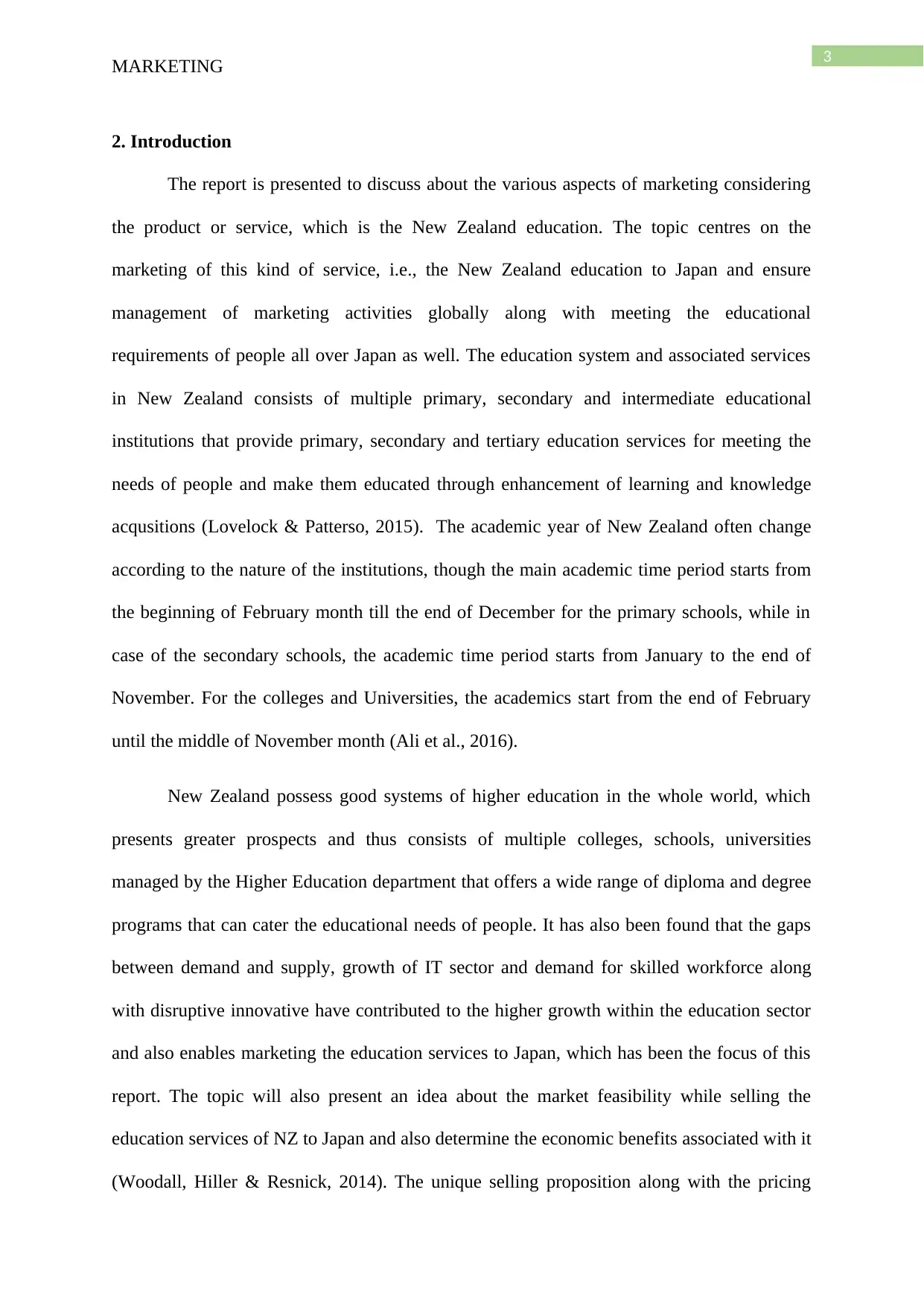
3
MARKETING
2. Introduction
The report is presented to discuss about the various aspects of marketing considering
the product or service, which is the New Zealand education. The topic centres on the
marketing of this kind of service, i.e., the New Zealand education to Japan and ensure
management of marketing activities globally along with meeting the educational
requirements of people all over Japan as well. The education system and associated services
in New Zealand consists of multiple primary, secondary and intermediate educational
institutions that provide primary, secondary and tertiary education services for meeting the
needs of people and make them educated through enhancement of learning and knowledge
acqusitions (Lovelock & Patterso, 2015). The academic year of New Zealand often change
according to the nature of the institutions, though the main academic time period starts from
the beginning of February month till the end of December for the primary schools, while in
case of the secondary schools, the academic time period starts from January to the end of
November. For the colleges and Universities, the academics start from the end of February
until the middle of November month (Ali et al., 2016).
New Zealand possess good systems of higher education in the whole world, which
presents greater prospects and thus consists of multiple colleges, schools, universities
managed by the Higher Education department that offers a wide range of diploma and degree
programs that can cater the educational needs of people. It has also been found that the gaps
between demand and supply, growth of IT sector and demand for skilled workforce along
with disruptive innovative have contributed to the higher growth within the education sector
and also enables marketing the education services to Japan, which has been the focus of this
report. The topic will also present an idea about the market feasibility while selling the
education services of NZ to Japan and also determine the economic benefits associated with it
(Woodall, Hiller & Resnick, 2014). The unique selling proposition along with the pricing
MARKETING
2. Introduction
The report is presented to discuss about the various aspects of marketing considering
the product or service, which is the New Zealand education. The topic centres on the
marketing of this kind of service, i.e., the New Zealand education to Japan and ensure
management of marketing activities globally along with meeting the educational
requirements of people all over Japan as well. The education system and associated services
in New Zealand consists of multiple primary, secondary and intermediate educational
institutions that provide primary, secondary and tertiary education services for meeting the
needs of people and make them educated through enhancement of learning and knowledge
acqusitions (Lovelock & Patterso, 2015). The academic year of New Zealand often change
according to the nature of the institutions, though the main academic time period starts from
the beginning of February month till the end of December for the primary schools, while in
case of the secondary schools, the academic time period starts from January to the end of
November. For the colleges and Universities, the academics start from the end of February
until the middle of November month (Ali et al., 2016).
New Zealand possess good systems of higher education in the whole world, which
presents greater prospects and thus consists of multiple colleges, schools, universities
managed by the Higher Education department that offers a wide range of diploma and degree
programs that can cater the educational needs of people. It has also been found that the gaps
between demand and supply, growth of IT sector and demand for skilled workforce along
with disruptive innovative have contributed to the higher growth within the education sector
and also enables marketing the education services to Japan, which has been the focus of this
report. The topic will also present an idea about the market feasibility while selling the
education services of NZ to Japan and also determine the economic benefits associated with it
(Woodall, Hiller & Resnick, 2014). The unique selling proposition along with the pricing
Paraphrase This Document
Need a fresh take? Get an instant paraphrase of this document with our AI Paraphraser
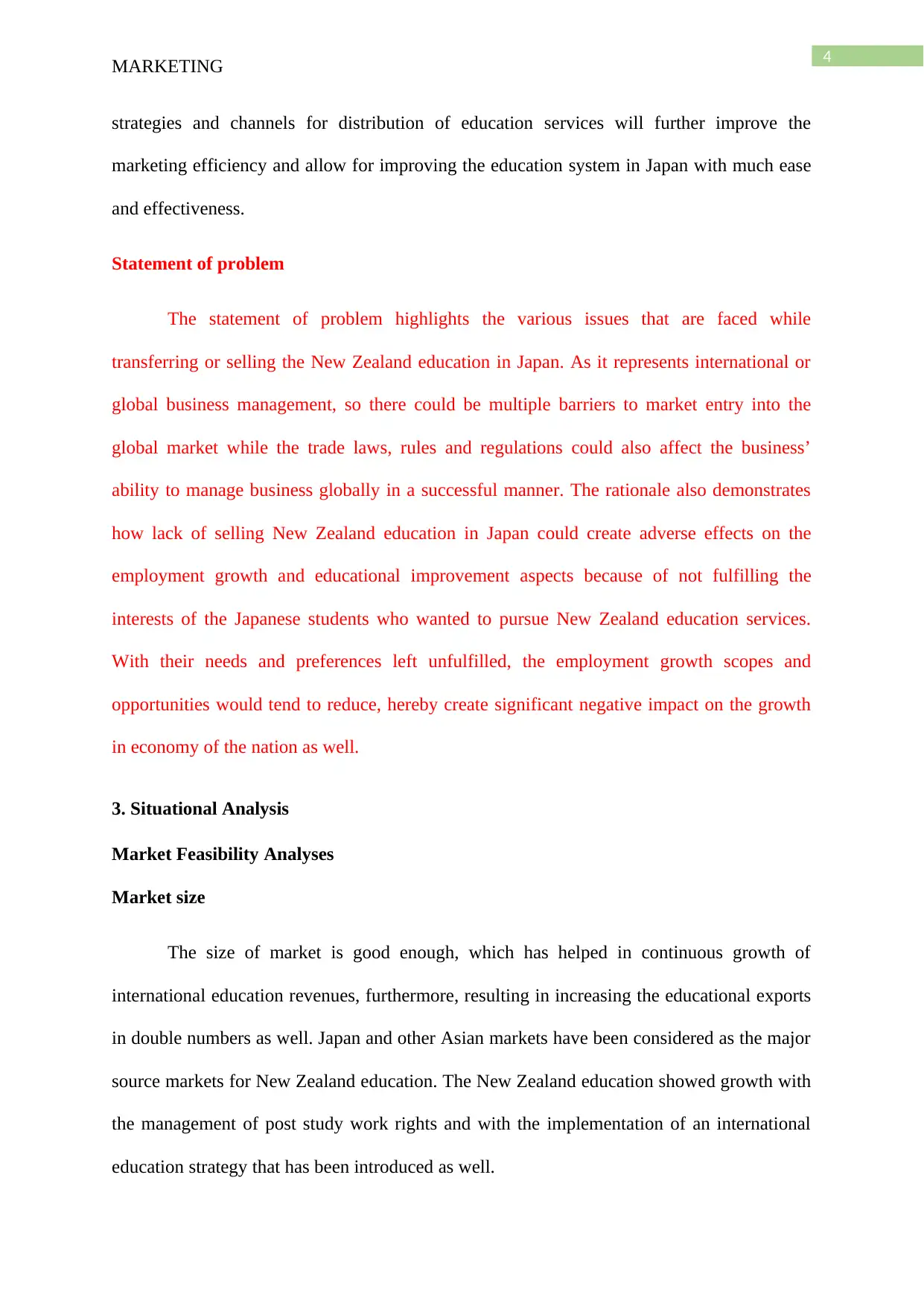
4
MARKETING
strategies and channels for distribution of education services will further improve the
marketing efficiency and allow for improving the education system in Japan with much ease
and effectiveness.
Statement of problem
The statement of problem highlights the various issues that are faced while
transferring or selling the New Zealand education in Japan. As it represents international or
global business management, so there could be multiple barriers to market entry into the
global market while the trade laws, rules and regulations could also affect the business’
ability to manage business globally in a successful manner. The rationale also demonstrates
how lack of selling New Zealand education in Japan could create adverse effects on the
employment growth and educational improvement aspects because of not fulfilling the
interests of the Japanese students who wanted to pursue New Zealand education services.
With their needs and preferences left unfulfilled, the employment growth scopes and
opportunities would tend to reduce, hereby create significant negative impact on the growth
in economy of the nation as well.
3. Situational Analysis
Market Feasibility Analyses
Market size
The size of market is good enough, which has helped in continuous growth of
international education revenues, furthermore, resulting in increasing the educational exports
in double numbers as well. Japan and other Asian markets have been considered as the major
source markets for New Zealand education. The New Zealand education showed growth with
the management of post study work rights and with the implementation of an international
education strategy that has been introduced as well.
MARKETING
strategies and channels for distribution of education services will further improve the
marketing efficiency and allow for improving the education system in Japan with much ease
and effectiveness.
Statement of problem
The statement of problem highlights the various issues that are faced while
transferring or selling the New Zealand education in Japan. As it represents international or
global business management, so there could be multiple barriers to market entry into the
global market while the trade laws, rules and regulations could also affect the business’
ability to manage business globally in a successful manner. The rationale also demonstrates
how lack of selling New Zealand education in Japan could create adverse effects on the
employment growth and educational improvement aspects because of not fulfilling the
interests of the Japanese students who wanted to pursue New Zealand education services.
With their needs and preferences left unfulfilled, the employment growth scopes and
opportunities would tend to reduce, hereby create significant negative impact on the growth
in economy of the nation as well.
3. Situational Analysis
Market Feasibility Analyses
Market size
The size of market is good enough, which has helped in continuous growth of
international education revenues, furthermore, resulting in increasing the educational exports
in double numbers as well. Japan and other Asian markets have been considered as the major
source markets for New Zealand education. The New Zealand education showed growth with
the management of post study work rights and with the implementation of an international
education strategy that has been introduced as well.
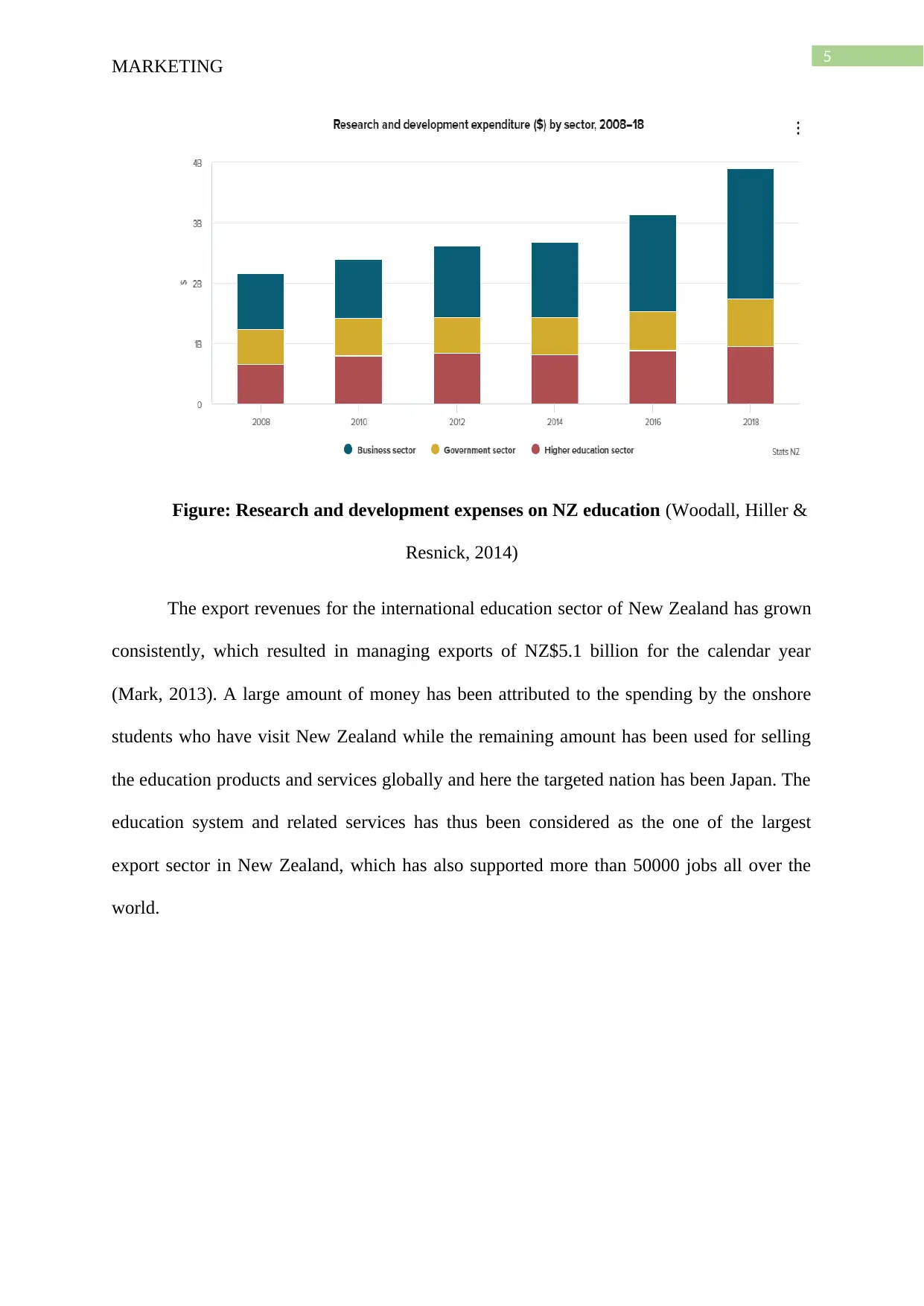
5
MARKETING
Figure: Research and development expenses on NZ education (Woodall, Hiller &
Resnick, 2014)
The export revenues for the international education sector of New Zealand has grown
consistently, which resulted in managing exports of NZ$5.1 billion for the calendar year
(Mark, 2013). A large amount of money has been attributed to the spending by the onshore
students who have visit New Zealand while the remaining amount has been used for selling
the education products and services globally and here the targeted nation has been Japan. The
education system and related services has thus been considered as the one of the largest
export sector in New Zealand, which has also supported more than 50000 jobs all over the
world.
MARKETING
Figure: Research and development expenses on NZ education (Woodall, Hiller &
Resnick, 2014)
The export revenues for the international education sector of New Zealand has grown
consistently, which resulted in managing exports of NZ$5.1 billion for the calendar year
(Mark, 2013). A large amount of money has been attributed to the spending by the onshore
students who have visit New Zealand while the remaining amount has been used for selling
the education products and services globally and here the targeted nation has been Japan. The
education system and related services has thus been considered as the one of the largest
export sector in New Zealand, which has also supported more than 50000 jobs all over the
world.
⊘ This is a preview!⊘
Do you want full access?
Subscribe today to unlock all pages.

Trusted by 1+ million students worldwide
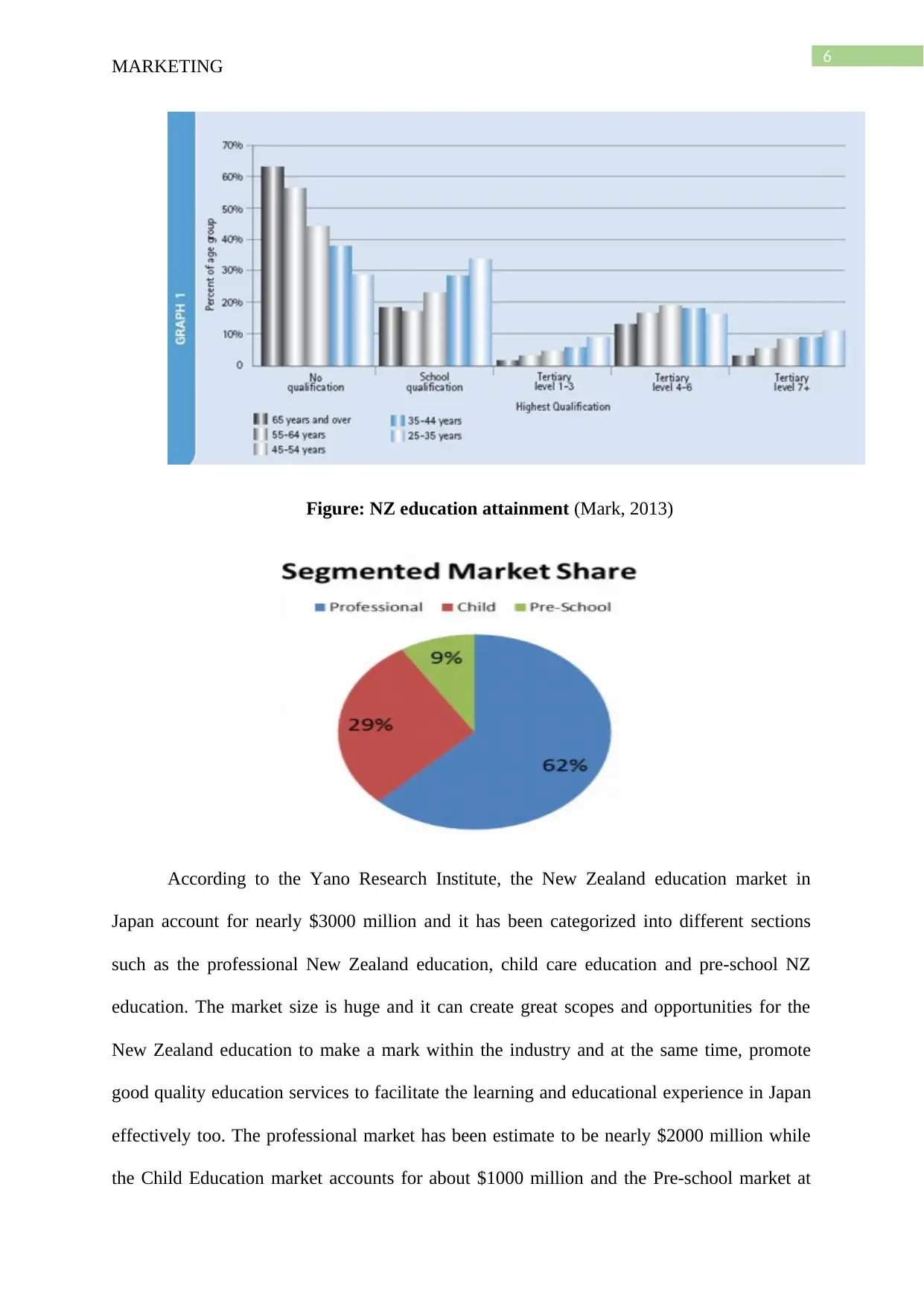
6
MARKETING
Figure: NZ education attainment (Mark, 2013)
According to the Yano Research Institute, the New Zealand education market in
Japan account for nearly $3000 million and it has been categorized into different sections
such as the professional New Zealand education, child care education and pre-school NZ
education. The market size is huge and it can create great scopes and opportunities for the
New Zealand education to make a mark within the industry and at the same time, promote
good quality education services to facilitate the learning and educational experience in Japan
effectively too. The professional market has been estimate to be nearly $2000 million while
the Child Education market accounts for about $1000 million and the Pre-school market at
MARKETING
Figure: NZ education attainment (Mark, 2013)
According to the Yano Research Institute, the New Zealand education market in
Japan account for nearly $3000 million and it has been categorized into different sections
such as the professional New Zealand education, child care education and pre-school NZ
education. The market size is huge and it can create great scopes and opportunities for the
New Zealand education to make a mark within the industry and at the same time, promote
good quality education services to facilitate the learning and educational experience in Japan
effectively too. The professional market has been estimate to be nearly $2000 million while
the Child Education market accounts for about $1000 million and the Pre-school market at
Paraphrase This Document
Need a fresh take? Get an instant paraphrase of this document with our AI Paraphraser
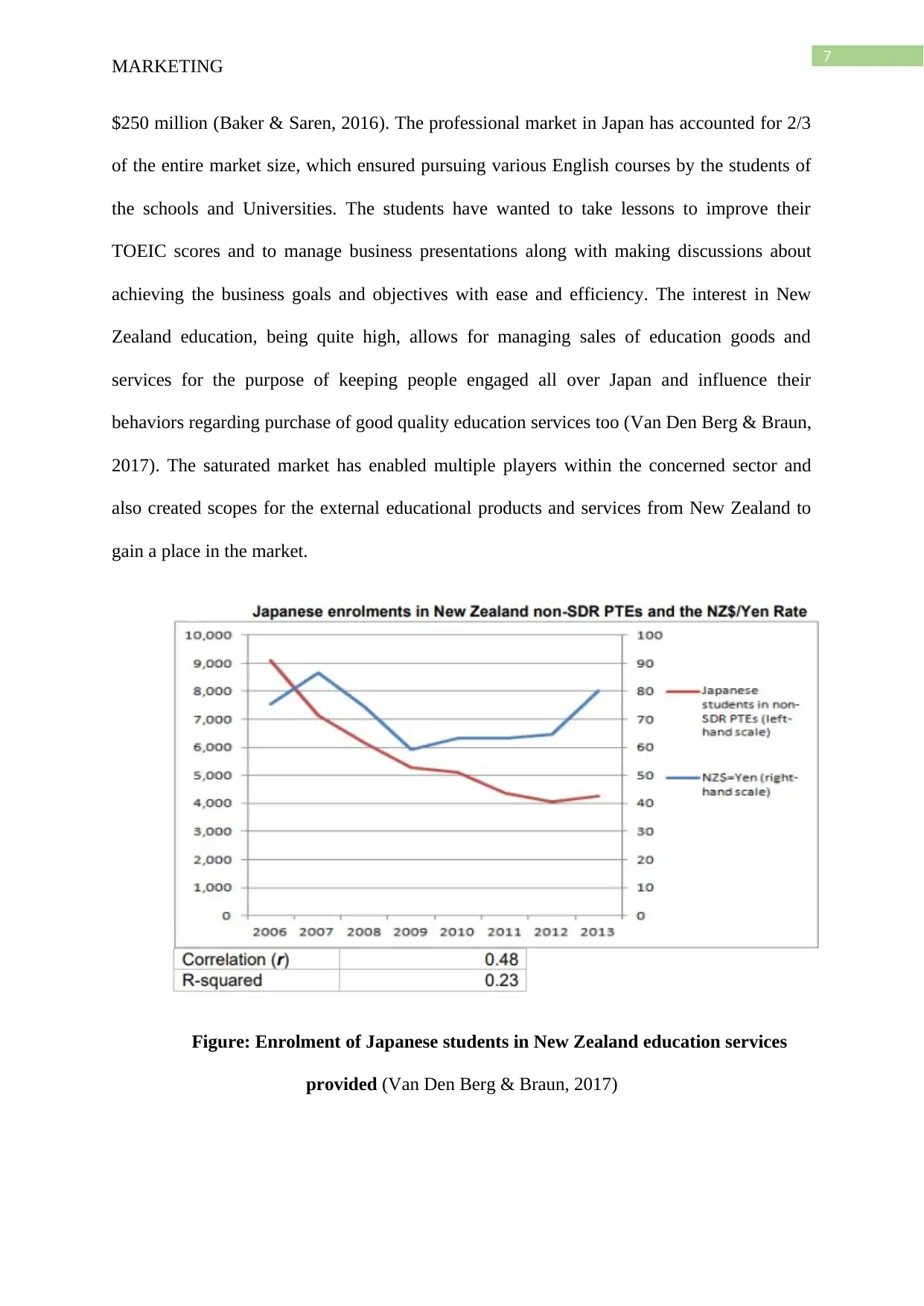
7
MARKETING
$250 million (Baker & Saren, 2016). The professional market in Japan has accounted for 2/3
of the entire market size, which ensured pursuing various English courses by the students of
the schools and Universities. The students have wanted to take lessons to improve their
TOEIC scores and to manage business presentations along with making discussions about
achieving the business goals and objectives with ease and efficiency. The interest in New
Zealand education, being quite high, allows for managing sales of education goods and
services for the purpose of keeping people engaged all over Japan and influence their
behaviors regarding purchase of good quality education services too (Van Den Berg & Braun,
2017). The saturated market has enabled multiple players within the concerned sector and
also created scopes for the external educational products and services from New Zealand to
gain a place in the market.
Figure: Enrolment of Japanese students in New Zealand education services
provided (Van Den Berg & Braun, 2017)
MARKETING
$250 million (Baker & Saren, 2016). The professional market in Japan has accounted for 2/3
of the entire market size, which ensured pursuing various English courses by the students of
the schools and Universities. The students have wanted to take lessons to improve their
TOEIC scores and to manage business presentations along with making discussions about
achieving the business goals and objectives with ease and efficiency. The interest in New
Zealand education, being quite high, allows for managing sales of education goods and
services for the purpose of keeping people engaged all over Japan and influence their
behaviors regarding purchase of good quality education services too (Van Den Berg & Braun,
2017). The saturated market has enabled multiple players within the concerned sector and
also created scopes for the external educational products and services from New Zealand to
gain a place in the market.
Figure: Enrolment of Japanese students in New Zealand education services
provided (Van Den Berg & Braun, 2017)
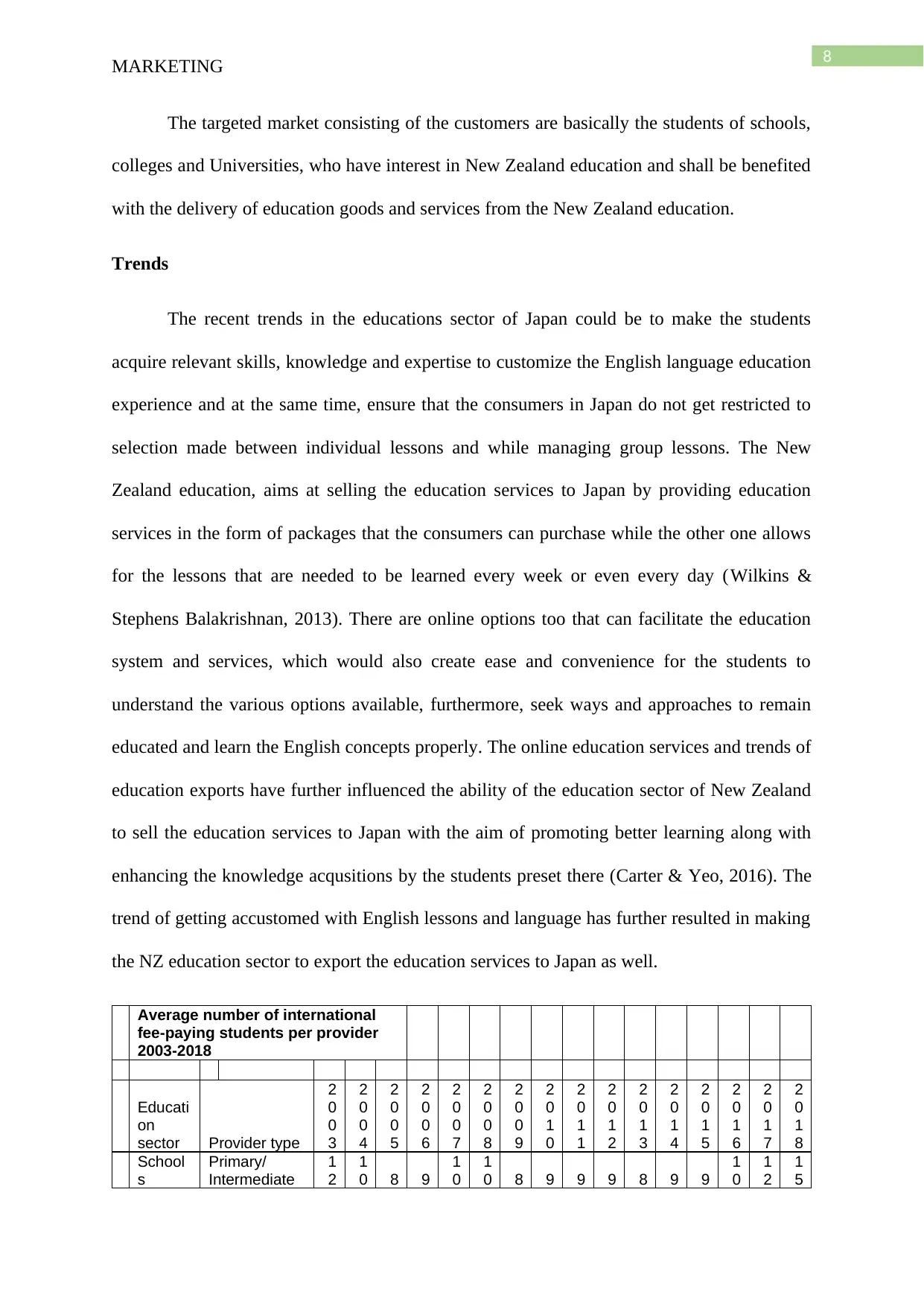
8
MARKETING
The targeted market consisting of the customers are basically the students of schools,
colleges and Universities, who have interest in New Zealand education and shall be benefited
with the delivery of education goods and services from the New Zealand education.
Trends
The recent trends in the educations sector of Japan could be to make the students
acquire relevant skills, knowledge and expertise to customize the English language education
experience and at the same time, ensure that the consumers in Japan do not get restricted to
selection made between individual lessons and while managing group lessons. The New
Zealand education, aims at selling the education services to Japan by providing education
services in the form of packages that the consumers can purchase while the other one allows
for the lessons that are needed to be learned every week or even every day (Wilkins &
Stephens Balakrishnan, 2013). There are online options too that can facilitate the education
system and services, which would also create ease and convenience for the students to
understand the various options available, furthermore, seek ways and approaches to remain
educated and learn the English concepts properly. The online education services and trends of
education exports have further influenced the ability of the education sector of New Zealand
to sell the education services to Japan with the aim of promoting better learning along with
enhancing the knowledge acqusitions by the students preset there (Carter & Yeo, 2016). The
trend of getting accustomed with English lessons and language has further resulted in making
the NZ education sector to export the education services to Japan as well.
Average number of international
fee-paying students per provider
2003-2018
Educati
on
sector Provider type
2
0
0
3
2
0
0
4
2
0
0
5
2
0
0
6
2
0
0
7
2
0
0
8
2
0
0
9
2
0
1
0
2
0
1
1
2
0
1
2
2
0
1
3
2
0
1
4
2
0
1
5
2
0
1
6
2
0
1
7
2
0
1
8
School
s
Primary/
Intermediate
1
2
1
0 8 9
1
0
1
0 8 9 9 9 8 9 9
1
0
1
2
1
5
MARKETING
The targeted market consisting of the customers are basically the students of schools,
colleges and Universities, who have interest in New Zealand education and shall be benefited
with the delivery of education goods and services from the New Zealand education.
Trends
The recent trends in the educations sector of Japan could be to make the students
acquire relevant skills, knowledge and expertise to customize the English language education
experience and at the same time, ensure that the consumers in Japan do not get restricted to
selection made between individual lessons and while managing group lessons. The New
Zealand education, aims at selling the education services to Japan by providing education
services in the form of packages that the consumers can purchase while the other one allows
for the lessons that are needed to be learned every week or even every day (Wilkins &
Stephens Balakrishnan, 2013). There are online options too that can facilitate the education
system and services, which would also create ease and convenience for the students to
understand the various options available, furthermore, seek ways and approaches to remain
educated and learn the English concepts properly. The online education services and trends of
education exports have further influenced the ability of the education sector of New Zealand
to sell the education services to Japan with the aim of promoting better learning along with
enhancing the knowledge acqusitions by the students preset there (Carter & Yeo, 2016). The
trend of getting accustomed with English lessons and language has further resulted in making
the NZ education sector to export the education services to Japan as well.
Average number of international
fee-paying students per provider
2003-2018
Educati
on
sector Provider type
2
0
0
3
2
0
0
4
2
0
0
5
2
0
0
6
2
0
0
7
2
0
0
8
2
0
0
9
2
0
1
0
2
0
1
1
2
0
1
2
2
0
1
3
2
0
1
4
2
0
1
5
2
0
1
6
2
0
1
7
2
0
1
8
School
s
Primary/
Intermediate
1
2
1
0 8 9
1
0
1
0 8 9 9 9 8 9 9
1
0
1
2
1
5
⊘ This is a preview!⊘
Do you want full access?
Subscribe today to unlock all pages.

Trusted by 1+ million students worldwide
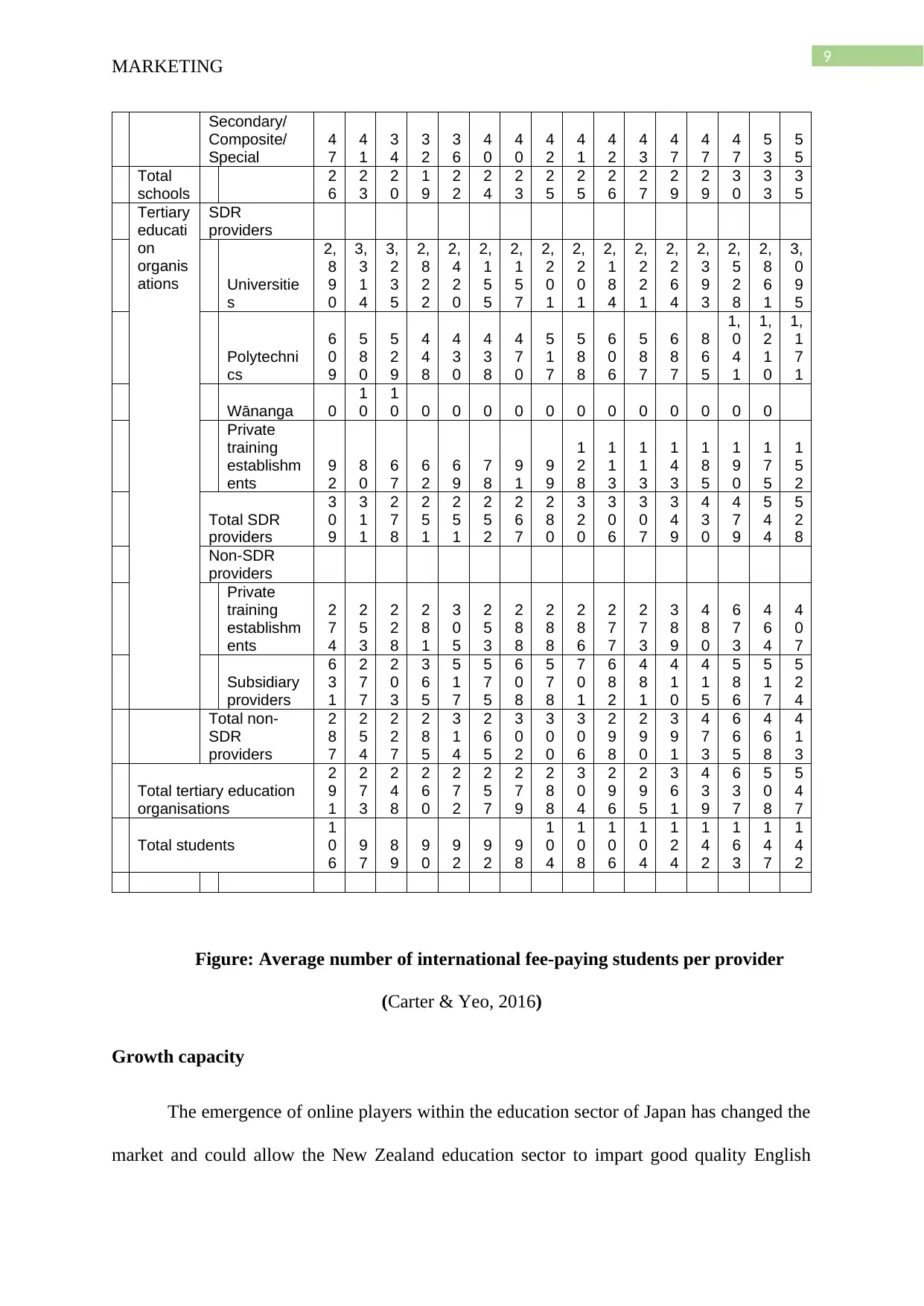
9
MARKETING
Secondary/
Composite/
Special
4
7
4
1
3
4
3
2
3
6
4
0
4
0
4
2
4
1
4
2
4
3
4
7
4
7
4
7
5
3
5
5
Total
schools
2
6
2
3
2
0
1
9
2
2
2
4
2
3
2
5
2
5
2
6
2
7
2
9
2
9
3
0
3
3
3
5
Tertiary
educati
on
organis
ations
SDR
providers
Universitie
s
2,
8
9
0
3,
3
1
4
3,
2
3
5
2,
8
2
2
2,
4
2
0
2,
1
5
5
2,
1
5
7
2,
2
0
1
2,
2
0
1
2,
1
8
4
2,
2
2
1
2,
2
6
4
2,
3
9
3
2,
5
2
8
2,
8
6
1
3,
0
9
5
Polytechni
cs
6
0
9
5
8
0
5
2
9
4
4
8
4
3
0
4
3
8
4
7
0
5
1
7
5
8
8
6
0
6
5
8
7
6
8
7
8
6
5
1,
0
4
1
1,
2
1
0
1,
1
7
1
Wānanga 0
1
0
1
0 0 0 0 0 0 0 0 0 0 0 0 0
Private
training
establishm
ents
9
2
8
0
6
7
6
2
6
9
7
8
9
1
9
9
1
2
8
1
1
3
1
1
3
1
4
3
1
8
5
1
9
0
1
7
5
1
5
2
Total SDR
providers
3
0
9
3
1
1
2
7
8
2
5
1
2
5
1
2
5
2
2
6
7
2
8
0
3
2
0
3
0
6
3
0
7
3
4
9
4
3
0
4
7
9
5
4
4
5
2
8
Non-SDR
providers
Private
training
establishm
ents
2
7
4
2
5
3
2
2
8
2
8
1
3
0
5
2
5
3
2
8
8
2
8
8
2
8
6
2
7
7
2
7
3
3
8
9
4
8
0
6
7
3
4
6
4
4
0
7
Subsidiary
providers
6
3
1
2
7
7
2
0
3
3
6
5
5
1
7
5
7
5
6
0
8
5
7
8
7
0
1
6
8
2
4
8
1
4
1
0
4
1
5
5
8
6
5
1
7
5
2
4
Total non-
SDR
providers
2
8
7
2
5
4
2
2
7
2
8
5
3
1
4
2
6
5
3
0
2
3
0
0
3
0
6
2
9
8
2
9
0
3
9
1
4
7
3
6
6
5
4
6
8
4
1
3
Total tertiary education
organisations
2
9
1
2
7
3
2
4
8
2
6
0
2
7
2
2
5
7
2
7
9
2
8
8
3
0
4
2
9
6
2
9
5
3
6
1
4
3
9
6
3
7
5
0
8
5
4
7
Total students
1
0
6
9
7
8
9
9
0
9
2
9
2
9
8
1
0
4
1
0
8
1
0
6
1
0
4
1
2
4
1
4
2
1
6
3
1
4
7
1
4
2
Figure: Average number of international fee-paying students per provider
(Carter & Yeo, 2016)
Growth capacity
The emergence of online players within the education sector of Japan has changed the
market and could allow the New Zealand education sector to impart good quality English
MARKETING
Secondary/
Composite/
Special
4
7
4
1
3
4
3
2
3
6
4
0
4
0
4
2
4
1
4
2
4
3
4
7
4
7
4
7
5
3
5
5
Total
schools
2
6
2
3
2
0
1
9
2
2
2
4
2
3
2
5
2
5
2
6
2
7
2
9
2
9
3
0
3
3
3
5
Tertiary
educati
on
organis
ations
SDR
providers
Universitie
s
2,
8
9
0
3,
3
1
4
3,
2
3
5
2,
8
2
2
2,
4
2
0
2,
1
5
5
2,
1
5
7
2,
2
0
1
2,
2
0
1
2,
1
8
4
2,
2
2
1
2,
2
6
4
2,
3
9
3
2,
5
2
8
2,
8
6
1
3,
0
9
5
Polytechni
cs
6
0
9
5
8
0
5
2
9
4
4
8
4
3
0
4
3
8
4
7
0
5
1
7
5
8
8
6
0
6
5
8
7
6
8
7
8
6
5
1,
0
4
1
1,
2
1
0
1,
1
7
1
Wānanga 0
1
0
1
0 0 0 0 0 0 0 0 0 0 0 0 0
Private
training
establishm
ents
9
2
8
0
6
7
6
2
6
9
7
8
9
1
9
9
1
2
8
1
1
3
1
1
3
1
4
3
1
8
5
1
9
0
1
7
5
1
5
2
Total SDR
providers
3
0
9
3
1
1
2
7
8
2
5
1
2
5
1
2
5
2
2
6
7
2
8
0
3
2
0
3
0
6
3
0
7
3
4
9
4
3
0
4
7
9
5
4
4
5
2
8
Non-SDR
providers
Private
training
establishm
ents
2
7
4
2
5
3
2
2
8
2
8
1
3
0
5
2
5
3
2
8
8
2
8
8
2
8
6
2
7
7
2
7
3
3
8
9
4
8
0
6
7
3
4
6
4
4
0
7
Subsidiary
providers
6
3
1
2
7
7
2
0
3
3
6
5
5
1
7
5
7
5
6
0
8
5
7
8
7
0
1
6
8
2
4
8
1
4
1
0
4
1
5
5
8
6
5
1
7
5
2
4
Total non-
SDR
providers
2
8
7
2
5
4
2
2
7
2
8
5
3
1
4
2
6
5
3
0
2
3
0
0
3
0
6
2
9
8
2
9
0
3
9
1
4
7
3
6
6
5
4
6
8
4
1
3
Total tertiary education
organisations
2
9
1
2
7
3
2
4
8
2
6
0
2
7
2
2
5
7
2
7
9
2
8
8
3
0
4
2
9
6
2
9
5
3
6
1
4
3
9
6
3
7
5
0
8
5
4
7
Total students
1
0
6
9
7
8
9
9
0
9
2
9
2
9
8
1
0
4
1
0
8
1
0
6
1
0
4
1
2
4
1
4
2
1
6
3
1
4
7
1
4
2
Figure: Average number of international fee-paying students per provider
(Carter & Yeo, 2016)
Growth capacity
The emergence of online players within the education sector of Japan has changed the
market and could allow the New Zealand education sector to impart good quality English
Paraphrase This Document
Need a fresh take? Get an instant paraphrase of this document with our AI Paraphraser
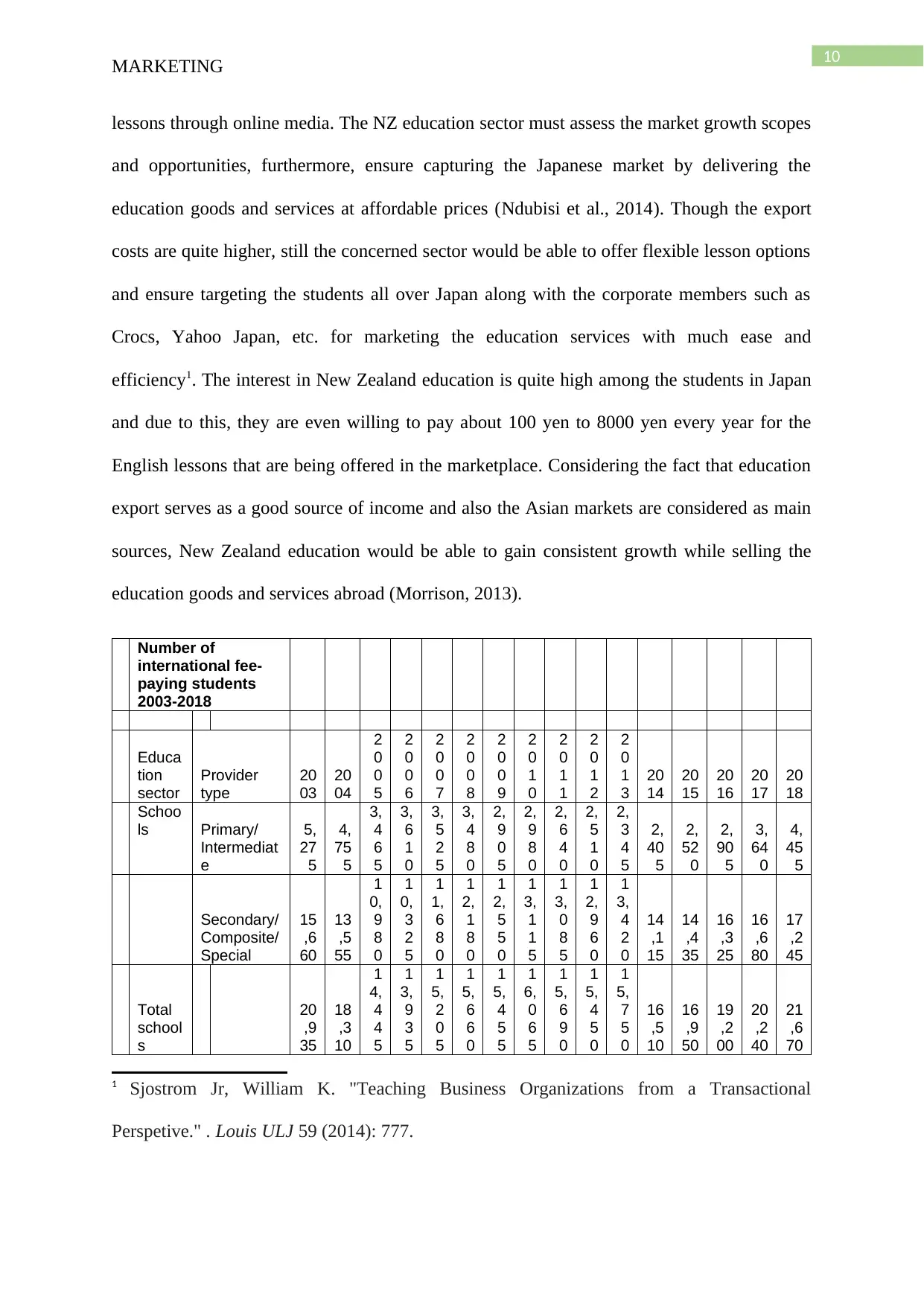
10
MARKETING
lessons through online media. The NZ education sector must assess the market growth scopes
and opportunities, furthermore, ensure capturing the Japanese market by delivering the
education goods and services at affordable prices (Ndubisi et al., 2014). Though the export
costs are quite higher, still the concerned sector would be able to offer flexible lesson options
and ensure targeting the students all over Japan along with the corporate members such as
Crocs, Yahoo Japan, etc. for marketing the education services with much ease and
efficiency1. The interest in New Zealand education is quite high among the students in Japan
and due to this, they are even willing to pay about 100 yen to 8000 yen every year for the
English lessons that are being offered in the marketplace. Considering the fact that education
export serves as a good source of income and also the Asian markets are considered as main
sources, New Zealand education would be able to gain consistent growth while selling the
education goods and services abroad (Morrison, 2013).
Number of
international fee-
paying students
2003-2018
Educa
tion
sector
Provider
type
20
03
20
04
2
0
0
5
2
0
0
6
2
0
0
7
2
0
0
8
2
0
0
9
2
0
1
0
2
0
1
1
2
0
1
2
2
0
1
3
20
14
20
15
20
16
20
17
20
18
Schoo
ls Primary/
Intermediat
e
5,
27
5
4,
75
5
3,
4
6
5
3,
6
1
0
3,
5
2
5
3,
4
8
0
2,
9
0
5
2,
9
8
0
2,
6
4
0
2,
5
1
0
2,
3
4
5
2,
40
5
2,
52
0
2,
90
5
3,
64
0
4,
45
5
Secondary/
Composite/
Special
15
,6
60
13
,5
55
1
0,
9
8
0
1
0,
3
2
5
1
1,
6
8
0
1
2,
1
8
0
1
2,
5
5
0
1
3,
1
1
5
1
3,
0
8
5
1
2,
9
6
0
1
3,
4
2
0
14
,1
15
14
,4
35
16
,3
25
16
,6
80
17
,2
45
Total
school
s
20
,9
35
18
,3
10
1
4,
4
4
5
1
3,
9
3
5
1
5,
2
0
5
1
5,
6
6
0
1
5,
4
5
5
1
6,
0
6
5
1
5,
6
9
0
1
5,
4
5
0
1
5,
7
5
0
16
,5
10
16
,9
50
19
,2
00
20
,2
40
21
,6
70
1 Sjostrom Jr, William K. "Teaching Business Organizations from a Transactional
Perspetive." . Louis ULJ 59 (2014): 777.
MARKETING
lessons through online media. The NZ education sector must assess the market growth scopes
and opportunities, furthermore, ensure capturing the Japanese market by delivering the
education goods and services at affordable prices (Ndubisi et al., 2014). Though the export
costs are quite higher, still the concerned sector would be able to offer flexible lesson options
and ensure targeting the students all over Japan along with the corporate members such as
Crocs, Yahoo Japan, etc. for marketing the education services with much ease and
efficiency1. The interest in New Zealand education is quite high among the students in Japan
and due to this, they are even willing to pay about 100 yen to 8000 yen every year for the
English lessons that are being offered in the marketplace. Considering the fact that education
export serves as a good source of income and also the Asian markets are considered as main
sources, New Zealand education would be able to gain consistent growth while selling the
education goods and services abroad (Morrison, 2013).
Number of
international fee-
paying students
2003-2018
Educa
tion
sector
Provider
type
20
03
20
04
2
0
0
5
2
0
0
6
2
0
0
7
2
0
0
8
2
0
0
9
2
0
1
0
2
0
1
1
2
0
1
2
2
0
1
3
20
14
20
15
20
16
20
17
20
18
Schoo
ls Primary/
Intermediat
e
5,
27
5
4,
75
5
3,
4
6
5
3,
6
1
0
3,
5
2
5
3,
4
8
0
2,
9
0
5
2,
9
8
0
2,
6
4
0
2,
5
1
0
2,
3
4
5
2,
40
5
2,
52
0
2,
90
5
3,
64
0
4,
45
5
Secondary/
Composite/
Special
15
,6
60
13
,5
55
1
0,
9
8
0
1
0,
3
2
5
1
1,
6
8
0
1
2,
1
8
0
1
2,
5
5
0
1
3,
1
1
5
1
3,
0
8
5
1
2,
9
6
0
1
3,
4
2
0
14
,1
15
14
,4
35
16
,3
25
16
,6
80
17
,2
45
Total
school
s
20
,9
35
18
,3
10
1
4,
4
4
5
1
3,
9
3
5
1
5,
2
0
5
1
5,
6
6
0
1
5,
4
5
5
1
6,
0
6
5
1
5,
6
9
0
1
5,
4
5
0
1
5,
7
5
0
16
,5
10
16
,9
50
19
,2
00
20
,2
40
21
,6
70
1 Sjostrom Jr, William K. "Teaching Business Organizations from a Transactional
Perspetive." . Louis ULJ 59 (2014): 777.
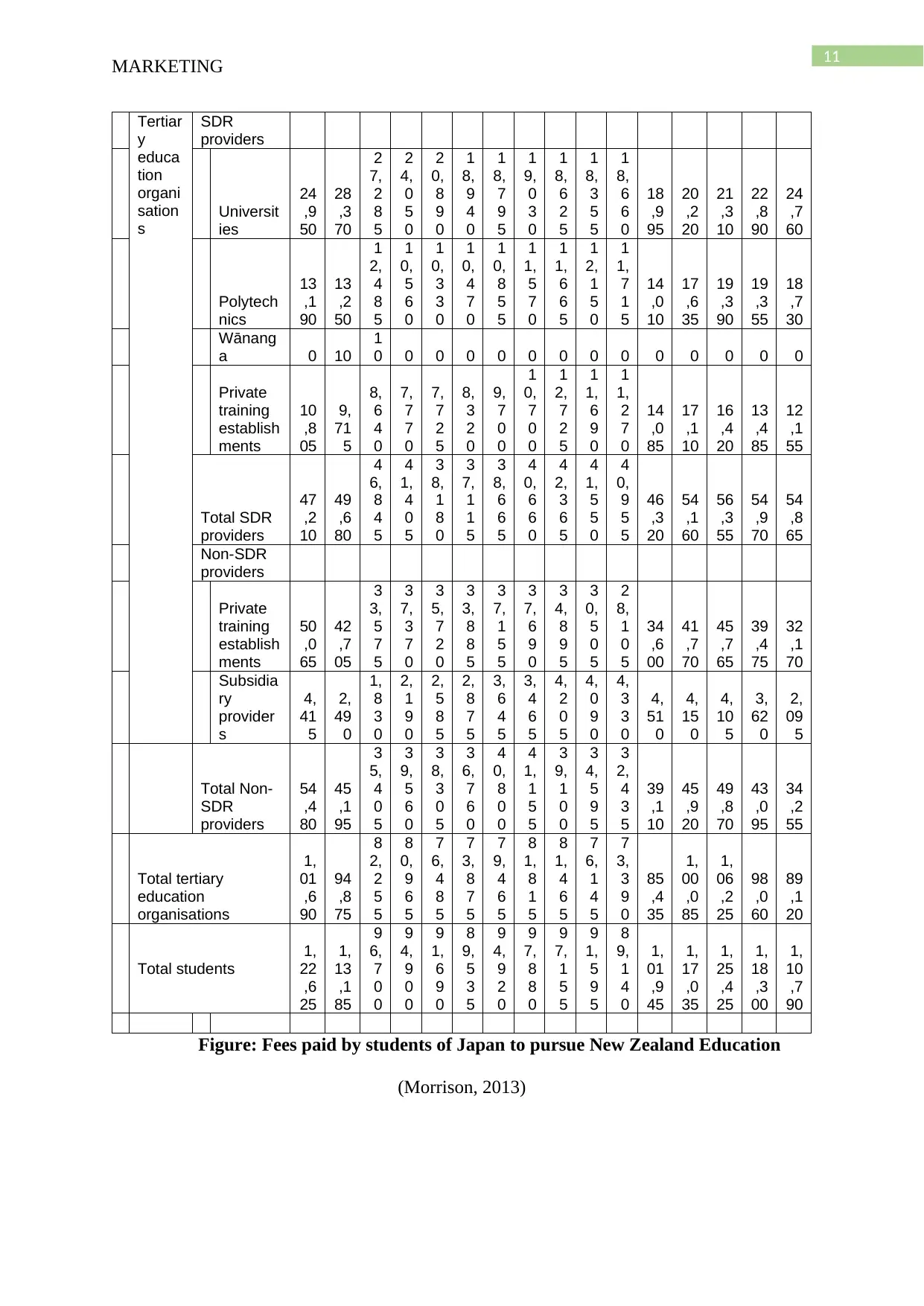
11
MARKETING
Tertiar
y
educa
tion
organi
sation
s
SDR
providers
Universit
ies
24
,9
50
28
,3
70
2
7,
2
8
5
2
4,
0
5
0
2
0,
8
9
0
1
8,
9
4
0
1
8,
7
9
5
1
9,
0
3
0
1
8,
6
2
5
1
8,
3
5
5
1
8,
6
6
0
18
,9
95
20
,2
20
21
,3
10
22
,8
90
24
,7
60
Polytech
nics
13
,1
90
13
,2
50
1
2,
4
8
5
1
0,
5
6
0
1
0,
3
3
0
1
0,
4
7
0
1
0,
8
5
5
1
1,
5
7
0
1
1,
6
6
5
1
2,
1
5
0
1
1,
7
1
5
14
,0
10
17
,6
35
19
,3
90
19
,3
55
18
,7
30
Wānang
a 0 10
1
0 0 0 0 0 0 0 0 0 0 0 0 0 0
Private
training
establish
ments
10
,8
05
9,
71
5
8,
6
4
0
7,
7
7
0
7,
7
2
5
8,
3
2
0
9,
7
0
0
1
0,
7
0
0
1
2,
7
2
5
1
1,
6
9
0
1
1,
2
7
0
14
,0
85
17
,1
10
16
,4
20
13
,4
85
12
,1
55
Total SDR
providers
47
,2
10
49
,6
80
4
6,
8
4
5
4
1,
4
0
5
3
8,
1
8
0
3
7,
1
1
5
3
8,
6
6
5
4
0,
6
6
0
4
2,
3
6
5
4
1,
5
5
0
4
0,
9
5
5
46
,3
20
54
,1
60
56
,3
55
54
,9
70
54
,8
65
Non-SDR
providers
Private
training
establish
ments
50
,0
65
42
,7
05
3
3,
5
7
5
3
7,
3
7
0
3
5,
7
2
0
3
3,
8
8
5
3
7,
1
5
5
3
7,
6
9
0
3
4,
8
9
5
3
0,
5
0
5
2
8,
1
0
5
34
,6
00
41
,7
70
45
,7
65
39
,4
75
32
,1
70
Subsidia
ry
provider
s
4,
41
5
2,
49
0
1,
8
3
0
2,
1
9
0
2,
5
8
5
2,
8
7
5
3,
6
4
5
3,
4
6
5
4,
2
0
5
4,
0
9
0
4,
3
3
0
4,
51
0
4,
15
0
4,
10
5
3,
62
0
2,
09
5
Total Non-
SDR
providers
54
,4
80
45
,1
95
3
5,
4
0
5
3
9,
5
6
0
3
8,
3
0
5
3
6,
7
6
0
4
0,
8
0
0
4
1,
1
5
5
3
9,
1
0
0
3
4,
5
9
5
3
2,
4
3
5
39
,1
10
45
,9
20
49
,8
70
43
,0
95
34
,2
55
Total tertiary
education
organisations
1,
01
,6
90
94
,8
75
8
2,
2
5
5
8
0,
9
6
5
7
6,
4
8
5
7
3,
8
7
5
7
9,
4
6
5
8
1,
8
1
5
8
1,
4
6
5
7
6,
1
4
5
7
3,
3
9
0
85
,4
35
1,
00
,0
85
1,
06
,2
25
98
,0
60
89
,1
20
Total students
1,
22
,6
25
1,
13
,1
85
9
6,
7
0
0
9
4,
9
0
0
9
1,
6
9
0
8
9,
5
3
5
9
4,
9
2
0
9
7,
8
8
0
9
7,
1
5
5
9
1,
5
9
5
8
9,
1
4
0
1,
01
,9
45
1,
17
,0
35
1,
25
,4
25
1,
18
,3
00
1,
10
,7
90
Figure: Fees paid by students of Japan to pursue New Zealand Education
(Morrison, 2013)
MARKETING
Tertiar
y
educa
tion
organi
sation
s
SDR
providers
Universit
ies
24
,9
50
28
,3
70
2
7,
2
8
5
2
4,
0
5
0
2
0,
8
9
0
1
8,
9
4
0
1
8,
7
9
5
1
9,
0
3
0
1
8,
6
2
5
1
8,
3
5
5
1
8,
6
6
0
18
,9
95
20
,2
20
21
,3
10
22
,8
90
24
,7
60
Polytech
nics
13
,1
90
13
,2
50
1
2,
4
8
5
1
0,
5
6
0
1
0,
3
3
0
1
0,
4
7
0
1
0,
8
5
5
1
1,
5
7
0
1
1,
6
6
5
1
2,
1
5
0
1
1,
7
1
5
14
,0
10
17
,6
35
19
,3
90
19
,3
55
18
,7
30
Wānang
a 0 10
1
0 0 0 0 0 0 0 0 0 0 0 0 0 0
Private
training
establish
ments
10
,8
05
9,
71
5
8,
6
4
0
7,
7
7
0
7,
7
2
5
8,
3
2
0
9,
7
0
0
1
0,
7
0
0
1
2,
7
2
5
1
1,
6
9
0
1
1,
2
7
0
14
,0
85
17
,1
10
16
,4
20
13
,4
85
12
,1
55
Total SDR
providers
47
,2
10
49
,6
80
4
6,
8
4
5
4
1,
4
0
5
3
8,
1
8
0
3
7,
1
1
5
3
8,
6
6
5
4
0,
6
6
0
4
2,
3
6
5
4
1,
5
5
0
4
0,
9
5
5
46
,3
20
54
,1
60
56
,3
55
54
,9
70
54
,8
65
Non-SDR
providers
Private
training
establish
ments
50
,0
65
42
,7
05
3
3,
5
7
5
3
7,
3
7
0
3
5,
7
2
0
3
3,
8
8
5
3
7,
1
5
5
3
7,
6
9
0
3
4,
8
9
5
3
0,
5
0
5
2
8,
1
0
5
34
,6
00
41
,7
70
45
,7
65
39
,4
75
32
,1
70
Subsidia
ry
provider
s
4,
41
5
2,
49
0
1,
8
3
0
2,
1
9
0
2,
5
8
5
2,
8
7
5
3,
6
4
5
3,
4
6
5
4,
2
0
5
4,
0
9
0
4,
3
3
0
4,
51
0
4,
15
0
4,
10
5
3,
62
0
2,
09
5
Total Non-
SDR
providers
54
,4
80
45
,1
95
3
5,
4
0
5
3
9,
5
6
0
3
8,
3
0
5
3
6,
7
6
0
4
0,
8
0
0
4
1,
1
5
5
3
9,
1
0
0
3
4,
5
9
5
3
2,
4
3
5
39
,1
10
45
,9
20
49
,8
70
43
,0
95
34
,2
55
Total tertiary
education
organisations
1,
01
,6
90
94
,8
75
8
2,
2
5
5
8
0,
9
6
5
7
6,
4
8
5
7
3,
8
7
5
7
9,
4
6
5
8
1,
8
1
5
8
1,
4
6
5
7
6,
1
4
5
7
3,
3
9
0
85
,4
35
1,
00
,0
85
1,
06
,2
25
98
,0
60
89
,1
20
Total students
1,
22
,6
25
1,
13
,1
85
9
6,
7
0
0
9
4,
9
0
0
9
1,
6
9
0
8
9,
5
3
5
9
4,
9
2
0
9
7,
8
8
0
9
7,
1
5
5
9
1,
5
9
5
8
9,
1
4
0
1,
01
,9
45
1,
17
,0
35
1,
25
,4
25
1,
18
,3
00
1,
10
,7
90
Figure: Fees paid by students of Japan to pursue New Zealand Education
(Morrison, 2013)
⊘ This is a preview!⊘
Do you want full access?
Subscribe today to unlock all pages.

Trusted by 1+ million students worldwide
1 out of 39
Related Documents
Your All-in-One AI-Powered Toolkit for Academic Success.
+13062052269
info@desklib.com
Available 24*7 on WhatsApp / Email
![[object Object]](/_next/static/media/star-bottom.7253800d.svg)
Unlock your academic potential
Copyright © 2020–2025 A2Z Services. All Rights Reserved. Developed and managed by ZUCOL.





